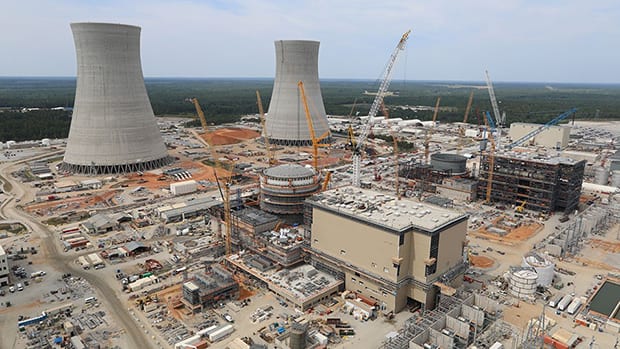How the Department of Energy Is Helping Keep Nuclear Power Relevant
The post How the Department of Energy Is Helping Keep Nuclear Power Relevant appeared first on POWER Magazine.

In the decade following World War II, the U.S. government took a keen interest in helping to create a commercial nuclear power industry. Although there were military leaders and members of Congress who believed nuclear technology should be carefully guarded and kept secret, many policymakers realized that other countries would quickly develop their own atomic capabilities; therefore, openly leading the world into the nuclear age presented opportunities, not only to exercise political control of the technical know-how, but also to profit from the growth of the new industry.
Among President Eisenhower's most famous public addresses is his Atoms for Peace" speech, which was given before the United Nations General Assembly on Dec. 8, 1953. In it, he said, The United States knows that peaceful power from atomic energy is no dream of the future; the capability-already proved-is here today." Four years and 10 days later, the Shippingport Atomic Power Station in Pennsylvania began generating commercial electricity, becoming the world's first full-scale nuclear power plant devoted exclusively to peacetime uses. It was built in 32 months at a cost of about $72.5 million and remained in operation until October 1982.
From Feast to FamineDuring the 1960s, there was extreme optimism surrounding the potential for nuclear power. The industry saw tremendous growth in the U.S., with hundreds of nuclear power plants placed on order by utilities of all sizes. By the mid-1970s, however, schedule delays and cost overruns on nuclear projects, coupled with slower growth in electricity demand, led to many plants being canceled prior to breaking ground or being abandoned during construction. The fact is, no reactor ordered in the U.S. after 1973 ever entered commercial operation.
During a March 26 presentation hosted by the American Nuclear Society, William D. Magwood IV, director-general of the Organisation for Economic Co-operation and Development (OECD) Nuclear Energy Agency, spoke about his time as director of the U.S. Department of Energy's (DOE's) Office of Nuclear Energy (NE), a position commonly referred to as NE-1 by insiders. Magwood suggested the government was doing more in the 1990s to hurt the nuclear industry than to help it.
When I came into the Department of Energy, it was during a big transition. Bill Clinton had been elected president, and in those days nuclear energy was not seen in very high favor," he said. One of the very first actions by the administration was to begin canceling nuclear research programs. They canceled the advanced liquid metal reactor program, the advanced gas reactor program, the space reactor program, the integral fast reactor program-and that was a very stunning change for a lot of people. The only program we had left was really the advanced light water reactor program, and that ended in the 1997 timeframe," said Magwood.
When 1998 came along, we actually had zero research dollars. It was the first time in the history of nuclear energy, really, that the DOE had no money. And so, the position that I was in when I was asked to take over the office of nuclear energy in 1998 was to start from scratch-to go from zero up to something," he said. And with a lot of help, we were successful."
Money Makes a DifferenceDuring Magwood's tenure as director of the DOE's nuclear program, which lasted until 2005, the Idaho National Laboratory (INL) was established, and important initiatives, such as the Generation IV International Forum and Nuclear Power 2010," were launched. The DOE's programs helped to kickstart nuclear plant construction projects in the U.S. again. Under Magwood's direction, more focus was also placed on education, and nuclear technology programs began to regain momentum at universities across the country.
Still, Congress wasn't allocating enormous sums of money toward nuclear programs when Magwood departed. When I left, even after we crawled out of that hole, we only were up to about $500 or $600 million," he recalled. That has changed substantially today. NE received $1,581,908,000 during fiscal year 2020 appropriations-the highest amount in history.
NE's mission is to advance nuclear energy science and technology to meet U.S. energy, environmental, and economic needs." Among NE's goals are helping the industry realize the potential of advanced technology and spurring innovation, so it's not surprising that a great deal of its money in 2020 went toward funding research and development (R&D) programs. Specifically, NE spent more than half its budget on fuel cycle R&D, including accident-tolerant fuels; reactor concepts research, development, and demonstration, including advanced small modular reactor R&D; and its Advanced Reactor Demonstration Program.
Magwood said many people in the 1990s would go silent when nuclear power was offered as a solution to reduce CO2 emissions. That has changed to some extent today, especially outside of the U.S.
Globally, there is not a stigma around nuclear that we see in the United States," said Rita Baranwal, who served as NE-1 from July 2019 to January 2021. That's really good news, I think, for the developers in the United States that do want to export their technology." Perhaps Eisenhower's vision of nuclear power providing abundant electrical energy in the power-starved areas of the world" will still come to pass. If it does, much of the credit should go to work sponsored by the DOE.
-Aaron Larsonis POWER's executive editor.
The post How the Department of Energy Is Helping Keep Nuclear Power Relevant appeared first on POWER Magazine.